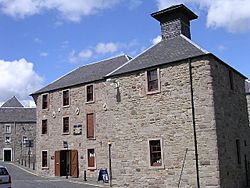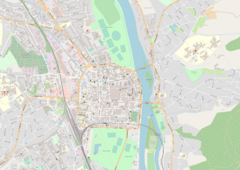Lower City Mills facts for kids

The entrance on Mill Wynd in 2005. Part of Upper City Mills is visible on the left
|
|
| Coordinates | 56°23′51″N 3°26′08″W / 56.397401°N 3.435559°W |
|---|---|
| Construction | |
| Completed | 1715 |
| Renovated |
|
| Water Power | |
| Diameter / width of water wheel | 4.7 m / 3.7 m |
| Equipment | |
| Mule Frames | |
|
Listed Building – Grade A
|
|
| Official name | Lower City Mills |
| Designated | 20 May 1965 |
| Reference no. | 39578 |
The Lower City Mills are old watermill buildings in Perth, Scotland. They are part of a group of mills called City Mills. In 1965, the Lower City Mills were given a special "Category A" listed status. This means they are very important historical buildings. People have been milling grain at this spot since the 1300s!
The Upper City Mills are right next to the Lower City Mills on West Mill Street. Together, these mills used to process different grains like wheat, oats, barley, and peas. They even helped make beer and bread from these ingredients.
Contents
A Long History of Milling
The right to use these mills was given by King Robert II way back in 1375. This was a special gift that allowed the mills to operate.
How the Mills Worked
Originally, there were two separate mill buildings. They stood on either side of the Perth Lade, which is a channel of water. This water powered the mills' big wheels. One building ground oats, and the other made pot barley and oats.
Later, these two mills were combined into one main building. A single, large water wheel was used. This wheel was 3.7 meters wide and 4.7 meters across. That's pretty big!
Rebuilding After a Fire
A map from 1715 shows a mill already existed at this spot. The Lower City Mills have been rebuilt several times over the years. In 1803, a fire damaged the buildings. After the fire, both mills were rebuilt around 1805. A mill expert named John Stewart designed the new buildings. He was the one who decided to use just one large water wheel instead of two. This was a busy time for mills in Perth.
In 1807, a study looked at how the mills worked. It found that the water from the lade dropped about thirteen feet from the upper mill to the lower one. The amount of water was huge, and if used well, it could create as much power as a 60-horsepower steam engine!
Changes Over Time
In the early 1900s, a company called James Macdonald & Son Grain Merchants and Millers used the mills. Their offices were nearby.
Modern Updates and Decline
In 1938, the mill stopped making barley. The machinery for barley was removed to make more space for storing oats. During this time, an early electric motor was added. This motor helped power a special oven for drying oats. This meant the water wheel could focus on sifting and grinding oats.
However, by 1953, the mill's business started to slow down. People were buying less oatmeal. British-grown wheat became more popular for bread, and bigger, newer mills could process grain much cheaper and faster.
To try and save the mill, two more electric motors were installed. But it wasn't enough, and the mill stopped all production in 1966.
The Mills Today
In the 1980s, the local council and other groups helped completely fix up the mill.
A Tourist Attraction
From the late 1980s through the 1990s, the mill mostly produced wheat flour for a local bakery. It also became a place for craft workshops and a tearoom. This made it a popular spot for tourists to visit.
In 2001, the Lower City Mills became home to the Perth Visitor Information Centre and the Perthshire Tourist Board. Later, VisitScotland used the building until June 2019.
Future Plans
Since 2012, the building has been on the Buildings at Risk Register. This means it needs special care to prevent it from falling apart. In November 2019, the Perth and Kinross Heritage Trust took over looking after the building. They use it as office space and hope to find a new, long-term use for this historic mill.


